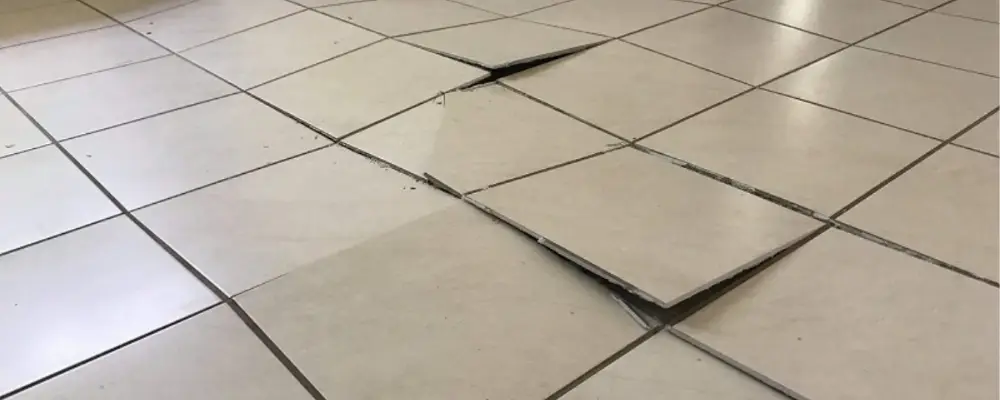Tiles have become one of the most essential elements of construction due to their aesthetic values, and durable and levelled flooring surface. It is mandatory to have a smooth and levelled flooring surface. However, tile popping is something that is very common and affects the structural integrity of a building. This blog will help you understand what tile popping is, with certain tips and tricks to have a durable tiled surface.
What is Tile Popping?
Tile popping is a common issue in tiled surfaces. In this issue, a tile or a bunch of tiles loosens itself from the substrate layer and pops out, creating a noticeable gap and bulge. In some cases, the tile will completely detach from the substrate, affecting the structural integrity and creating a hazardous surface.
Common Causes of Tile Popping
Inadequate Adhesive Coverage
If the mortar application is insufficient or not uniform throughout the tile surface, it creates a weak bond with the substrate, resulting in tile popping over time. A thin layer of adhesives, improper mixing or poor mortar spread, are some root causes of tile popping.
Substrate Preparation Issues
If the substrate is not properly cleaned, smoothed, or levelled before the tile installation, it creates poor bonding and uneven stress, causing the tile to loosen or pop up.
Moisture Intrusion
Moisture has a major impact on tile bonding and can adversely impact the structural integrity. Excessive moisture weakens the adhesives and grout, causing the tile to loosen. Improper waterproofing and dampness in the subfloor before installation, causes tiles to pop up.
Thermal Activities
Extreme temperature fluctuations can cause the mortar to contract and expand, which can cause tiles to crack or pop out of place. Thermal activities causing tile pops are pretty common in outdoor areas.
Poor Quality Materials
Using low-quality adhesives or grouting materials can cause poor bonding with the subfloor, causing long-term popping or failure. On the other hand, using low-quality tiles that have defects and imperfections can cause them to pop or crack.
Impact or Stress
When the tile surface is subjected to heavy loads or traffic, particularly in sloping areas, it can be vulnerable to popping or cracking in tiles or substrate.
How to Avoid Floor Tiles Popping Up?
Substrate Preparation
Ensure that the substrate is thoroughly cleaned and levelled to correct uneven surfaces and provide optimal bonding. Any moisture content in the substrate should be cleaned and coated with damp-proofing layers to enhance adhesion.
Use High-Quality Materials
Use high-quality tiles, mortar, grout and other adhesive materials for durable installations. It is necessary to ensure that the adhesive and grouts are suitable for specific tile applications and conditions.
Address Substrate Movement
Provide expansion joints to adapt to the natural movement and prevent stress buildup. To strengthen the substrate and minimise movements, reinforcement materials can be provided.
Sufficient Curing
Provide sufficient time for curing the adhesive and grout to achieve the necessary physical properties before heavy use and exposure to moisture. The curing time differs depending on the types of tiles and grouting materials used. It is recommended to follow the manufacturer’s instructions.
Regular Inspection and Maintenance
It is mandatory to have regular inspections of the tiled surface to address any issues at the early stages. Perform regular maintenance tasks, especially by resealing the grouting lines and repairing the cracked tiles to ensure structural integrity.
How To Fix Popping Tiles?
Inspect the Severity of Damage
It is necessary to assess the severity of tile popping by identifying the underlying factors. This can be done by checking the affected areas of damaged tiles. The severity of displacement and structural damage need to be addressed.
Remove Popped Tiles
After initial inspection, carefully remove the popped tiles from the substrate, and clean the surface using residual adhesive for a clean and smooth reinstallation.
Repair Tiles
Check the substrate for issues related to uneven surfaces, cracks, or moisture damage that caused the tiles to pop from the surface. Fix the surface issues before replacement to prevent the recurrence of the problem.
Replace Tiles
After preparing the substrate, the popped tiles should be replaced with new ones of the same size, style and material. Apply a fresh layer of mortar to the substrate surface and press the tiles firmly into place by aligning them with the surrounding tiles.
Grout and Seal
After the adhesive is completely cured, the tile joints are sealed with grouts using a float. Allow the grout to cure, based on the manufacturer’s instructions. Apply a sealer to protect the tile from moisture and stains.
Conclusion
Tile popping is one of the most common problems in tiled surfaces. Popping of tiles affects the structural integrity and requires regular maintenance. However, understanding the preventive measures and addressing the issues efficiently can help improve durability and resilience. Using the right quality materials, proper substrate preparation, and maintenance is key.
FAQs
The immediate steps you need to take after spotting tile pops is to inspect the severity of the damage, and the potential root cause behind it. In minor cases, the tiles can be reinstalled with fresh mortar. In case of multiple pops, consult a tile installer to repair and replace the popped tiles.
Yes, tile pops can occur in newly constructed homes if the installation is poor, excess load is placed on the surface, or if the tile experienced thermal expansion or compaction.
You can differentiate tile popping from other issues by performing certain physical inspections and simple tests. If the tile produces a hollow sound, has an uneven subfloor, weak adhesive bonding, or experiences heavy foot traffic, thermal fluctuations, or moisture attacks, tile popping is the major issue. Other conditions than this can be caused due to other issues.
Yes, climatic conditions play a major role in causing tile popping. Exposure to very hot or cold climatic conditions causes the substrate surface to expand or contract, resulting in the lifting of tiles.

